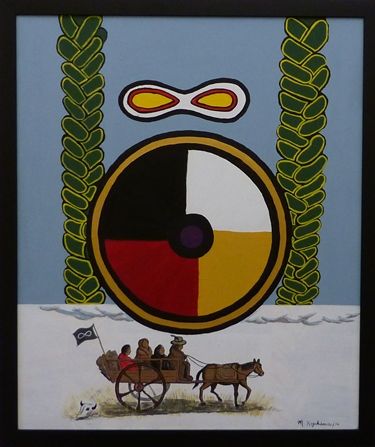
Students, instructors, guests and community members visiting Queen’s Faculty of Law will soon be welcomed into the building by a display of Indigenous artwork. The piece, which is part of the Faculty’s response to Calls to Action of the Truth and Reconciliation Commission of Canada and the final report of Queen’s Truth and Reconciliation Task Force, will directly reflect Indigenous peoples and their relationship to the law.
A 12-person committee, including seven Indigenous members, representing all the Faculty’s major stakeholders will oversee the project and has issued a call for artists to submit proposals. The committee includes Queen’s Law students, alumni, university representatives and members of the local First Nations communities. Internationally renowned architect and First Nations member Douglas Cardinal, OC, who will receive an honorary degree from Queen’s University at the law school’s convocation in June 2018, has graciously volunteered to serve on the committee.
“Canada’s greatest challenge today is to abolish the Indian Act, to respect the inherent rights of the Indigenous people of this land, and to fully acknowledge that they are all self-governing nations. Recognizing our Indigenous values and culture through the arts is an integral part of the reconciliation process,” Cardinal says.
Prominent First Nations businessman and committee member David Sharpe, Law’95, agrees. “I’ve been pleased to be involved with Queen’s Law for a number of years now as Aboriginal Ambassador and a member of the Dean’s Council,” Sharpe says. “This project represents another step forward in the school’s involvement and investment in recognizing the importance of First Nations culture and contributions.”
“One of the recommendations of the Queen’s report was to increase the presence of Indigenous cultures on campus,” says Cherie Metcalf, Associate Dean Academic, who represented the law school as part of the Queen’s University Truth and Reconciliation Task Force. “The artwork will be part of how we achieve that goal. It will also be an important visual symbol of the relationship between Indigenous people and the law. That relationship is an important element of our academic program here at the Faculty. It will be wonderful to see that every day."
The school’s atrium, the chosen location of the artwork, is a high-traffic hub visible from all floors of the building as well as the street. “The location is very exciting for us,” says Chantal Rousseau, Manager of International Programs and the project’s coordinator. “All students go through here, all faculty go through here, as well as visitors. It is a crossroads for the law school and will have a lot of meaning and resonance.”
“Queen’s University is situated on traditional Anishinaabe and Haudenosaunee Territory,” says Dean Bill Flanagan. “By honouring this traditional territory, we acknowledge the territory’s significance for the Indigenous peoples who lived, and continue to live, upon it. Having a work of art that reflects Indigenous culture and values in the entrance to our school will be one of many ways we honour this traditional territory and embrace Indigenous engagement in all that we do the Faculty of Law.”
The artist will interpret and ask viewers to look at some aspect of the law. The artwork will help create a welcoming environment for all students, but particularly for Indigenous students. “I am very pleased with the Indigenous art project initiative coming out of the Dean's office,” says committee member Jason Mercredi, Law’18, a Student Senator for the law school, and a member of the Queen’s Truth and Reconciliation Task Force. “This is a small but meaningful gesture of good faith towards reconciliation. This project also confirms Indigenous belonging within the law school community, which is particularly important in the study of colonial law.”
Interested artists can view the public art call.
By Anthony Pugh